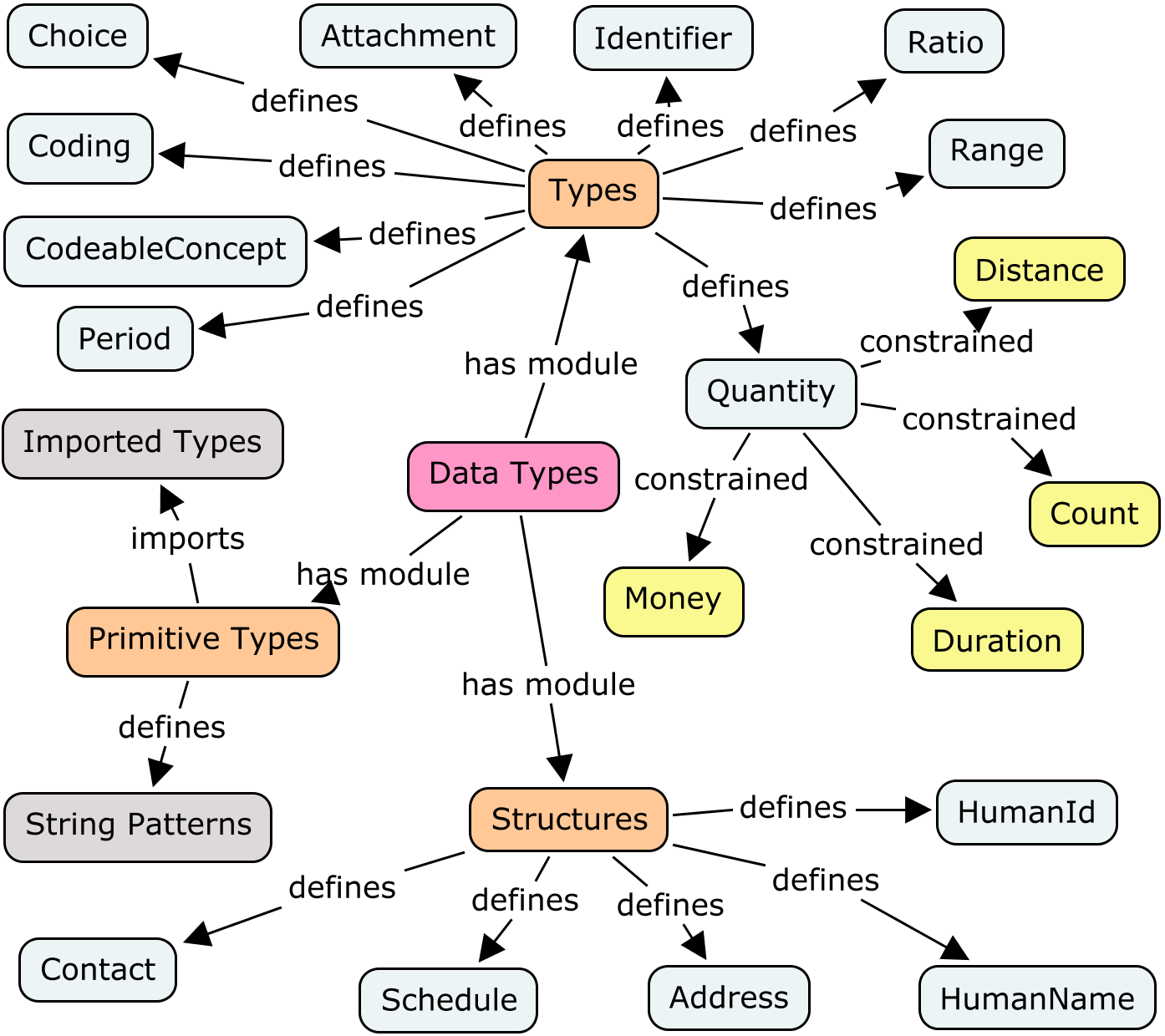 . Page versions: R5 R4B R4 R3 R2
. Page versions: R5 R4B R4 R3 R2This page is part of the FHIR Specification (v0.06: DSTU 1 Ballot 2). The current version which supercedes this version is 5.0.0. For a full list of available versions, see the Directory of published versions  . Page versions: R5 R4B R4 R3 R2
. Page versions: R5 R4B R4 R3 R2
This page includes additional examples of the data types, based on common usages and questions

A Simple example
<name>
<part>
<type>given</type>
<value>Adam</value>
</part>
<part>
<type>given</type>
<value>A.</value>
</part>
<part>
<type>family</type>
<value>Everyman</value>
</part>
</name>
Composite names
<name>
<part>
<type>given</type>
<value>Mary Jane</value>
</part>
<part>
<type>family</type>
<value>Contrata</value>
</part>
</name>
These cases can be quite ambiguous - is "Mary Jane" one name, or two? Different systems, and data enterers may treat this differently, and the person themselves may not know. Parts are allowed to contain spaces, but systems should consider how to treat these cases. Composite names separated by "-" should be treated as a single name part.
A common pattern: a person is called by a name other than that expected from their official name (first given name in most cultures).
<name>
<use>official</use>
<part>
<type>given</type>
<value>Peter</value>
</part>
<part>
<type>given</type>
<value>James</value>
</part>
<part>
<type>family</type>
<value>Chalmers</value>
</part>
</name>
<name>
<use>usual</use>
<part>
<type>given</type>
<value>Jim</value>
</part>
</name>
This same pattern is often encountered with immigrants, who retains their real name for official use, but adopt a localized name for everyday use:
<name>
<use>official</use>
<part>
<type>given</type>
<value>Piotr</value>
</part>
<part>
<type>given</type>
<value>Andre</value>
</part>
<part>
<type>family</type>
<value>Sczypinski</value>
</part>
</name>
<name>
<use>usual</use>
<part>
<type>given</type>
<value>Jim</value>
</part>
<part>
<type>family</type>
<value>Skipper</value>
</part>
</name>
Karen van Hentenryck is of Dutch origin, and the "van" is a voorvoegsel.
<name>
<use>official</use>
<part>
<type>given</type>
<value>Karen</value>
</part>
<part id="n1">
<type>family</type>
<value>van</value>
</part>
<part>
<type>family</type>
<value>Hentenryck</value>
</part>
</name>
<extension>
<code>name-qualifier</code>
<profile>http://hl7connect.healthintersections.com.au/svc/fhir/profile/@iso-21090</profile>
<ref>n1</>
<valueCode>VV</valueCode>
<extension>
Complex example from Germany: Dr.phil. Regina Johanna Maria Gräfin Hochheim-Weilenfels, NCFSA. This example shows extensive use of multiple given names, prefixes, suffixes, for academic degrees, nobility titles, and professional designations.
<name>
<use>official</use>
<part id="n1">
<type>prefix</type>
<value>Dr. phil..</value>
</part>
<part>
<type>given</type>
<value>Regina</value>
</part>
<part>
<type>given</type>
<value>Johanna</value>
</part>
<part>
<type>given</type>
<value>Maria</value>
</part>
<part id="n2">
<type>prefix</type>
<value>Gräfin</value>
</part>
<part>
<type>family</type>
<value>Hochheim-Weilenfels</value>
</part>
<part>
<type>suffix</type>
<value>NCFSA</value>
</part>
</name>
<name>
<use>maiden</use>
<part>
<type>given</type>
<value>Hochheim</value>
</part>
</name>
<!-- ... -->
<extension>
<code>name-qualifier</code>
<definition>http://hl7.org/fhir/profile/@iso-20190</definition>
<ref>n1</ref>
<valueCoding>
<code>AC</code>
<system>oid:2.16.840.1.113883.5.1122</system>
</valueCoding>
<extension>
<extension>
<code>name-qualifier</code>
<definition>http://hl7.org/fhir/profile/@iso-20190</definition>
<ref>n2</ref>
<valueCoding>
<code>NB</code>
<system>oid:2.16.840.1.113883.5.1122</system>
</valueCoding>
<extension>
This example makes use of the ISO 21090 extensions to carry the rare ISO 21090 qualifier attributes "AC" and "NB".
Japanese example in the three forms: ideographic (Kanji), syllabic (Hiragana) and alphabetic (Romaji).
<name>
<part>
<type>family</type>
<value>木村</value>
</part>
<part>
<type>given</type>
<value>通男</value>
</part>
</name>
<name>
<part>
<type>family</type>
<value>きむら;</value>
</part>
<part>
<type>given</type>
<value>みちお</value>
</part>
</name>
<name>
<part>
<type>family</type>
<value>KIMURA</value>
</part>
<part>
<type>given</type>
<value>MICHIO</value>
</part>
</name>
The three forms are differentiated by the character subset each contains.
Russian example in the two forms: cyrillic, and latin:
<name>
<part>
<type>family</type>
<value>ЕМЕЛИН</value>
</part>
<part>
<type>given</type>
<value>ИВАН</value>
</part>
<part>
<type>given</type>
<value>ВЛАДИМИРОВИЧ</value>
</part>
</name>
<name>
<part>
<type>family</type>
<value>EMELIN</value>
</part>
<part>
<type>given</type>
<value>IVAN</value>
</part>
</name>
In Russian usage, these names are known as the domestic and foreign names respectively. The two forms are differentiated by the character subset each contains.
Scandinavian example: Erikson is the family name. Jan Erik are the given names, and Östlund the family name of the mother, which is taken as a Mellannamn.
<name>
<use>official</use>
<part>
<type>given</type>
<value>Jan</value>
</part>
<part>
<type>given</type>
<value>Erik</value>
</part>
<part id="n1">
<type>given</type>
<value>Östlund</value>
</part>
<part>
<type>family</type>
<value>Erikson</value>
</part>
</name>
<!-- ... -->
<extension>
<code>name-qualifier</code>
<definition>http://hl7.org/fhir/profile/@iso-20190</definition>
<ref>n1</ref>
<valueCoding>
<code>MID</code>
<system>oid:2.16.840.1.113883.5.1122</system>
</valueCoding>
</extension>
This example makes use of the ISO 21090 extension to carry the culture specific ISO 21090 qualifier attribute "MID" for the Mellannamn.
Then Jan Erikson has a daughter, Karin, with his wife Margrete Hansen. The first communications of the new born name is "Margrete Jente" (Margrete's Girl) and the mother's family name, not the given name (Karin). The father's Family name is not used at all. This is a known temporary name assigned directly after the birth of the child.
<name>
<use>temp</use>
<!—- use could be OR+OLD, depends how record keeping is done -->
<part>
<type>given</type>
<value>Margrete Jente</value>
</part>
<part>
<type>family</type>
<value>Hansen</value>
</part>
</name>
The baby's name is subsequently changed to the fathers' family name, and to use the mother's name as mellomnamn.
<name>
<use>official</use>
<part>
<type>given</type>
<value>Karin</value>
</part>
<part id="n1">
<type>given</type>
<value>Hansen</value>
</part>
<part>
<type>family</type>
<value>Erikson</value>
</part>
</name>
<!-- ... -->
<extension>
<code>name-qualifier</code>
<definition>http://hl7.org/fhir/profile/@iso-20190</definition>
<ref>n1</ref>
<valueCoding>
<code>MID</code>
<system>oid:2.16.840.1.113883.5.1122</system>
</valueCoding>
</extension>
Later, Karin gets married to Per Berg, and decides to adopts Berg as her family name, and also decides to use Erikson as the mellom navn. (Note: Karin could have chosen to use another mellom navn, e.g. the family name of her mother, her father or other family names as specified by naming laws of the country in question).
<name>
<use>old</use>
<part>
<type>given</type>
<value>Karin</value>
</part>
<part id="n1">
<type>given</type>
<value>Hansen</value>
</part>
<part>
<type>family</type>
<value>Erikson</value>
</part>
</name>
<name>
<use>official</use>
<part>
<type>given</type>
<value>Karin</value>
</part>
<part id="n2">
<type>given</type>
<value>Erikson</value>
</part>
<part>
<type>family</type>
<value>Berg</value>
</part>
</name>
<name>
<use>usual</use>
<part>
<type>given</type>
<value>Karin</value>
</part>
<part>
<type>family</type>
<value>Berg</value>
</part>
</name>
<!-- ... -->
<extension>
<code>name-qualifier</code>
<definition>http://hl7.org/fhir/profile/@iso-20190</definition>
<ref>n1</ref>
<valueCoding>
<code>MID</code>
<system>oid:2.16.840.1.113883.5.1122</system>
</valueCoding>
</extension>
<extension>
<code>name-qualifier</code>
<definition>http://hl7.org/fhir/profile/@iso-20190</definition>
<ref>n2</ref>
<valueCoding>
<code>MID</code>
<system>oid:2.16.840.1.113883.5.1122</system>
</valueCoding>
</extension>
 This is an old version of FHIR retained for archive purposes. Do not use for anything else
This is an old version of FHIR retained for archive purposes. Do not use for anything else
Implementers are welcome to experiment with the content defined here, but should note that the contents are subject to change without prior notice.
© HL7.org 2011 - 2012. FHIR v0.06 generated on Tue, Dec 4, 2012 00:04+1100. License